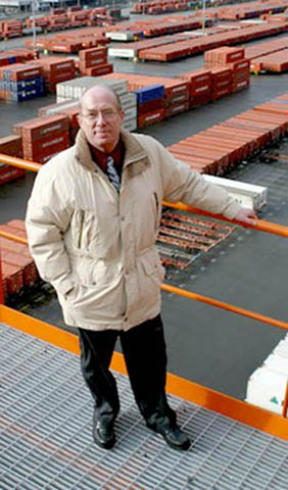It’s all about giving current and potential customers tools to upgrade their operations and increase efficiency, says the Port of Tacoma’s Technology Project Manager and Business Analyst Udo Mehlberg.
From high-atop a container crane at Washington United Terminals home to Hyundai Merchant Marine Mehlberg explains that new terminal simulation modeling has allowed Port of Tacoma customers, like Hyundai, be more successful. And, he reports, the technology is helping the Port attract new customers.
“It’s become a very effective marketing tool for us,” said Mehlberg. “Our recent successes in signing up customers for our container terminals occurred at least in part because of this software.”
In 2004, the Port of Tacoma signed Taiwan-based ocean carrier Yang Ming to a long-term lease at Terminal 7 and reached a re-stated lease arrangement for long-time customer I.T.S. to transition to Terminal 3-4, doubling the presence of Japan-based “K” Line in Tacoma.
Developed by the Bremerhaven, Germany-based Institute of Shipping Economics and Logistics, the terminal simulation modeling software includes both a “macro” function for long-range terminal planning and a “micro” tool to help with day-to-day operations. The component of the software package that gives the macro or big-picture, longer-term view of a terminal operation has been the most useful for the Port in dealing with current and prospective tenants, Mehlberg said. It is called CAPS, short for Capacity and Planning System.
CAPS examines variables, such as technology, equipment, acreage, staffing and production rates to predict the number of containers that can be moved through a terminal on an annual basis. “It starts a discussion of how a terminal can be enhanced, and how those enhancements in design, equipment or productivity would affect throughput,” Mehlberg explained.
SCUSY, which stands for Simulation of Container Handling Unit Systems, is for shorter-term planning and is often used by stevedoring companies and terminal operators. It helps them to determine the amount of equipment or the number and size of longshore gangs needed to move a given amount of cargo. Mehlberg describes it as an “operational support program that looks at a slice of time, probably the period of time when the vessel is in the berth.”
Simulation modeling has been used extensively by the Port since the late 1980s, but its usefulness became most apparent in the late 1990s, as bigger ships started coming into service. That meant terminals had to be more productive.
A misconception about terminal simulation programs is that when you plug in data, they deliver answers. The truth is, says Mehlberg, that the programs provide information that leads to discussions.
“We’re listening to our customers, and they’re telling us what they think they’re going to put through a terminal,” said Mike Zachary, the Port’s Director of Port Planning and Logistics. “Based on a terminal’s storage and operational capabilities, we give them a snapshot, and that opens a dialogue on what we can achieve at the terminal.”





